A Brief History
Written by Rosemarie Tenney, Parish Historian
In the Beginning
St. Malachy’s Catholic Parish was established in the village of Sherburne, New York in 1858 to serve the growing Irish immigrant population in the area. Mass had been initially held in private homes beginning around 1848. Once the Catholic population in the area began to grow, it became impossible for gatherings to be held in private homes and a larger place for regular worship was needed.
In early 1858 the Bishop of Albany created the parish and named it St. Malachy’s. The first purchase was land for the cemetery, acquired on April 13, 1858. The cemetery is located north of the church on School Street. The oldest tombstone there is for John Conley, who died on April 6, 1858. The first burial after the purchase of the land was Julia Donohue, who died May 16, 1858.
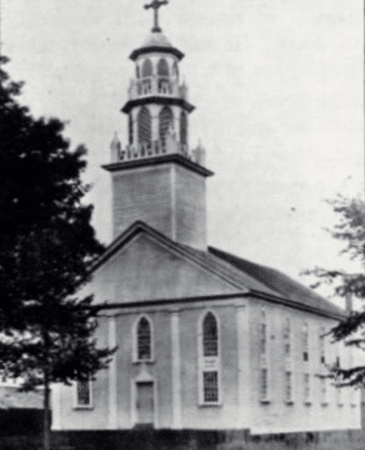
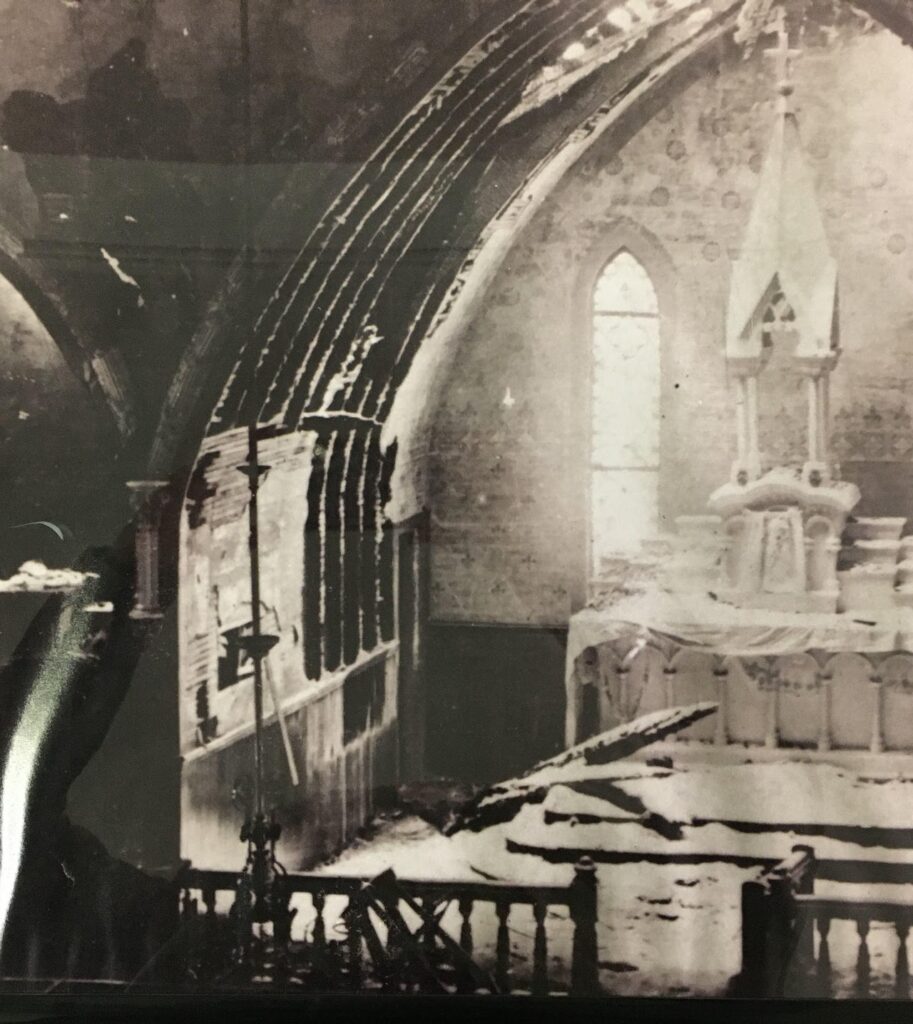
The Congregationalist Church had plans to build a new church in 1858 at the corner of state routes 12 and 80 and sold their church, located on North Main Street, the current location of the Big M Super Market to the Catholics. This building had originally been moved from a location on Foot Hill to the North Main Street location by the Congregationalists. St. Malachy’s Parish resided here for 65 years, before outgrowing the location. The church building was sold and eventually torn down after several other uses.
The catalyst for building a new church actually came out of a fire which severely damaged the old St. Malachy’s on January 1, 1910. Father Higgins, who came to Sherburne after the fire, believed the church would be too small for the growing number of parishioners and began to raise money to build a larger church. Over the next twelve years, plans were made and money set aside to build the current St. Malachy’s Church located at 29 East Main Street.
The process was long and never simple. After Fr. Higgins was transferred, Fr. Smith came to Sherburne in 1913. Fr. Smith found obstacles in the path to building a new church and cleverly found ways to overcome them. The main obstacle was purchasing property. The desired property was the George B. Whitmore Estate. Mr. Whitmore worked in the wholesale produce business and due to his success, the business was expanded and operation moved to a New York City office. The estate was rented and finally offered for sale. Father Smith realized that there may be objections to the Catholics buying the property, so he hired a Utica real estate agent, John Kelly, to act as purchaser. The property was purchased for $5,500 in 1913 and the final payment on that contract was made in 1914.
In 1918, Fr. Smith was transferred to Binghamton and Fr. David Dooling was sent to Sherburne. At the time, the parish had 65 families registered, most of moderate means. The January 1, 1918 financial report showed the cash on hand at $1,408.97. Over the next five years, Fr. Dooling led the parish to build an $85,000 church, and at the end of his tenure at St. Malachy’s left the parish with a debt of only $18,000 to finish paying. Fr. Dooling must have been very inspirational!
Part of the foundation work was done by parishioners who brought their teams of horses to town to help dig the foundation. Four women in the parish were known as the Building Fund Collectors. Their job was to collect fifty cents from each man and thirty cents from each woman in their area each week. This effort brought in $2,800 to the building fund. Other money was raised by card parties where people played for five cents at a time; families also made gifts to purchase the stained glass windows and other parts of the church.
The stained glass windows and Stations of the Cross were purchased from the Franz Mayer and Company of Munich, Germany at a total cost of $4,500 in 1922. We recently contacted the Mayer Company, and they sent us copies of their records showing the purchase orders for some of the stained glass windows. These records survived the devastation of World War II because an employee had the foresight to hide the company’s books for safekeeping.
The Cornerstone
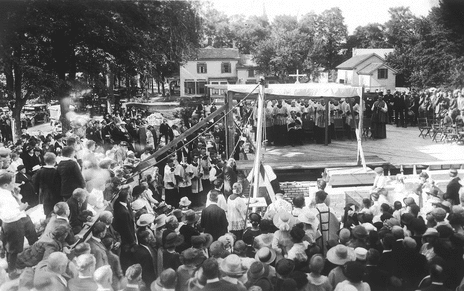

On Sunday, July 9, 1922, the cornerstone was laid during a ceremony attended by a large crowd of people from the entire Sherburne community as well as many others from neighboring towns. The Diocesan Vicar General Msgr. Hayes officiated in place of Bishop Grimes, who was taken ill. The local groups represented at the ceremony included the G.A.R., The American Legion, The Knights of Columbus of Norwich, and the Sherburne Masonic Lodge. The Binghamton Sun stated, “Sherburne is free of the petty jealousies and intolerance and even strife, common in some small communities.” It was a day where the entire community came together to celebrate.
Over the next year, construction progressed daily. The church is French Gothic in style, with two spires instead of one. The church was originally designed to hold 300 people. The church organ was built by the Beman Organ Company of Binghamton, and was restored in the early 1990’s through sponsorship of parishioners. There is a plaque in the church vestibule listing those who contributed.
Dedication
On June 17, 1923, the new St. Malachy’s Church was dedicated. The new bishop of Syracuse, Bishop Daniel Curley, officiated at that ceremony. According to the local papers, it was the largest crowd assembled for a public event of any kind in Sherburne. A sixty member male choir from St. Mary’s in Binghamton sang at the Mass, and the organ was played for the first time.
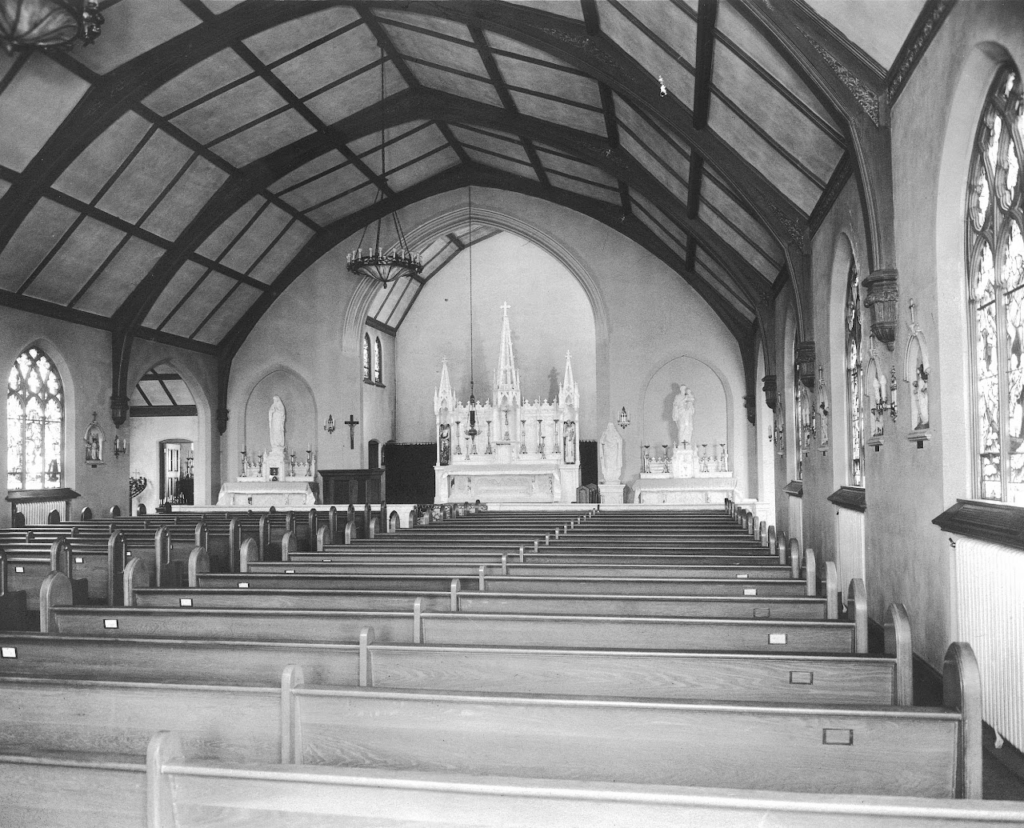
A little over a year later, the old altars which were moved from the North Main Street location to East State Street, were removed and sent to St. Mary’s in Skaneateles. The new Carrara marble altars, altar rails and statues were purchased for $10,000 and placed in the church. They were dedicated on August 24, 1924. This was one of Fr. Dooling’s last improvements to the church before he was transferred to Utica in 1925. His successor, Fr. Raymond Lawrence*, arrived in March. He inherited a debt of $17,000 which he diligently worked to reduce.
The church towers had no bells. Fr. Lawrence organized the children of the parish to raise money and buy the bells which ring in the towers today. By the time Fr. Lawrence left Sherburne, the debt was reduced to $8,000.
*Father Lawrence was not related to the Lawrence family of Sherburne. The family did name their ninth child Raymond, possibly in honor of Fr. Lawrence.
Fr. Edward Kissane succeeded Fr. Lawrence at St. Malachy’s in 1939. At this point in time, it was determined that the rectory, formerly the Whitmore home was in need of repairs. Fr. Kissane and the parishioners determined that the third story of the house was not used and expensive to heat, so it was removed and the roof put on the second story of the house. Fr. Kissane was energetic and thrifty, raising enough money during his time at St. Malachy’s to completely cancel the debt that remained when he took over the parish.
The Fire
The church was devastated by a fire on the morning of December 16, 1942. Discovered before 6 AM, it had been burning for some time. Fr. Kissane rushed into the building and saved the Blessed Sacrament from the tabernacle. Parts of the marble altar fell into the basement when the floor gave way. The roof was burned through for the entire length of the church. Fortunately someone had the foresight to open the vent windows on the stained glass windows. Although they suffered some damage from smoke and heat, they survived the fire and are intact today.
During the three month period it took to repair the church, Mass was held in the school auditorium on Sunday mornings. It is amazing to think that the work was completed so quickly as World War II policies were restricting access to materials and the usual workforce was at war. The roof was restored by the H.C. O’Connell Construction Company of Earlville. Other work was directed by Paul Huber, architect, and Rambusch Decorating of New York City.
By Sunday, March 21, 1943, the church was restored enough to have Mass there once again. The crucifix over the altar was a gift of Fr. Raymond Lawrence.
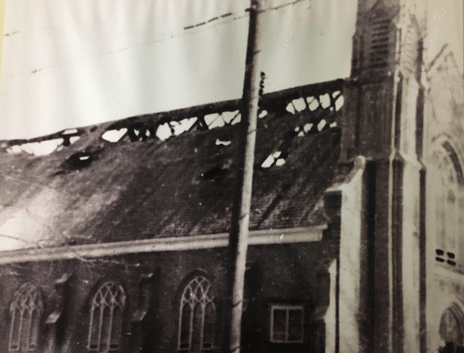
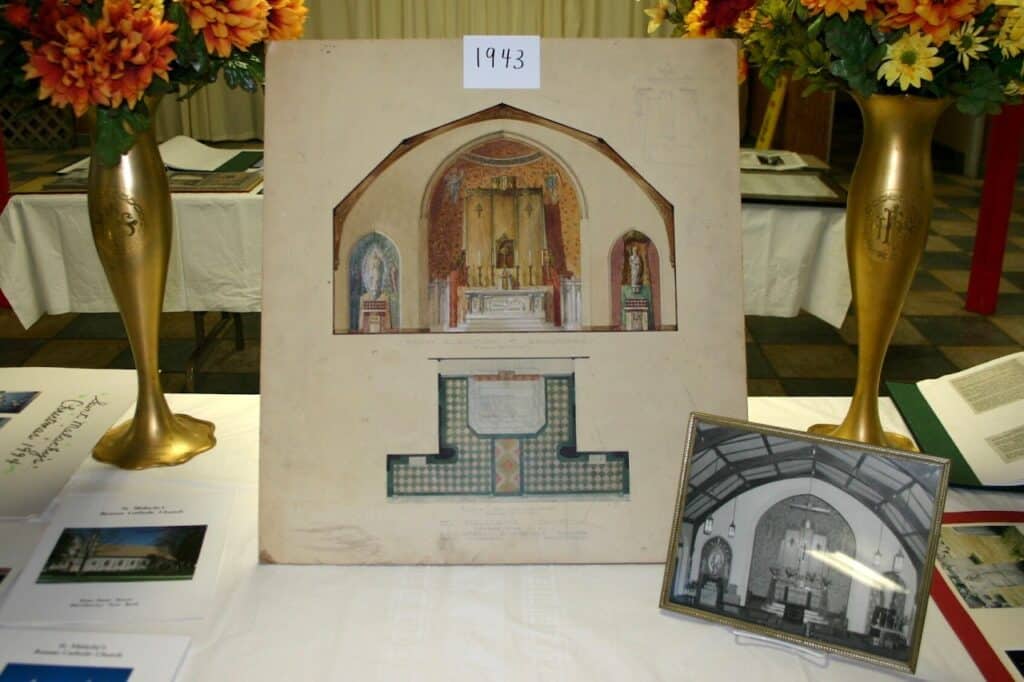
Post World War II – Present
After the war ended, life at St. Malachy’s settled into a routine. Fr. Kissane left Sherburne in 1949 and was replaced by Fr. Lawrence Daley who stayed at Sherburne until 1955. Fr. Lawrence Bassney was assigned to Sherburne that June and served the parish well until the early 1970’s when he retired and built a home on Chenango Avenue in Sherburne. During Fr. Bassney’s tenure, a mission parish, St. Theresa’s of the Infant Jesus, was created in New Berlin to serve the Catholics in our neighboring valley.
Fr. George Hurley succeeded Fr. Bassney and served St. Malachy’s until his death in the late 1970’s. There were a succession of priests over the next ten years, including Msgr. John Zeder and Fr. Laurence Lord.
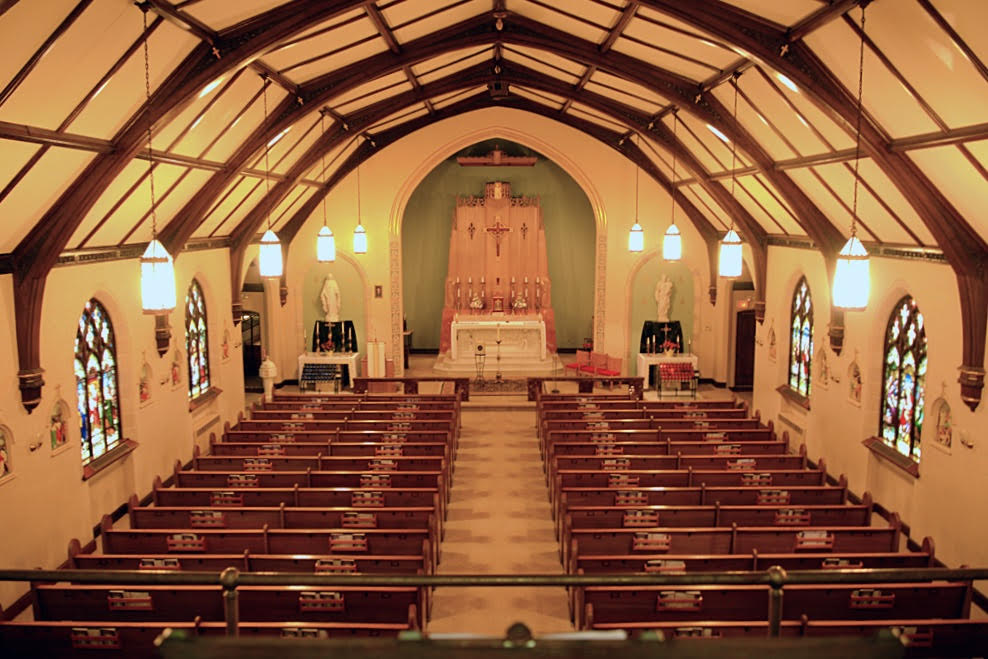
1990 Capital Project
In the fall of 1988 Fr. Edmund Castronovo was assigned to St. Malachy’s and spent the next 12 years building the parish both physically and spritiually. In 1990 a capital campaign was undertaken to restore the church with work on the structure and interior decoration. Fr. Castronovo also built up a large cadre of altar servers. Two of them, brothers James and Matthew Schultz, were both ordained to the priesthood in subsequent years.
When Fr. Castronovo was reassigned, Administrator Fr. Francis Case & Fr. John Broderick led the parish until Fr. Lester Smith agreed to come to St. Malachy’s in 2003. In the years of his service, St. Theresa’s parish was reunited with St. Malachy’s. Fr. Smith led St. Malachy’s until his retirement in spring 2018.
Fr. Gerald Lupa was named administrator of the parish, an assignment that was unfortunately cut short in November 2018 when he was recalled by Bishop Cunningham. The parish council and parishioners worked together to keep the parish going until a priest was found to take on St. Malachy’s and St. Theresa’s in New Berlin. Fr. Darr Schoenhofen was sent to lead both parishes. He served diligently until his health prevented him from continuing as parish administrator. Fr. Darr petitioned Bishop Lucia to allow him to retire to a hermitage and live a life of prayer and penance.
In Fall 2020, Fr. Krizysztof Boretto came to St. Malachy’s to serve as administrator until he planned to return to his hometown in Poland.
From March 2020 until July 2020, all parishes in New York State were closed as part of the New York Pause program initiated by Governor Cuomo due to the Covid-19 Pandemic. In order to reopen, churches were tasked to meet regulations from the diocese that included limited capacity, social distancing, omition of music, and a mask mandate to name a few. St. Malachy’s solicited volunteers to serve as ushers and church cleaners. Fortunately our parish is blessed with people who are willing to step up and help keep the church vital. Our prayer is that the pandemic ends soon and everyone who wishes to come to celebrate the sacrifice of the Mass will be able to join us.
At the end of January 2021, Father Boretto returned to Poland and Bishop Lucia sent Fr. Matthew Lyons to assume the post of temporary administrator beginning February 1, 2021.
As of July 2022, Father Caughey was welcomed into the Parish and is currently serving as the Parish Administrator.
*This page is a work in progress. If you have photos or historical details to share, please contact Parish Historian, Rosemarie Tenney or the Parish Office.
Stained Glass Windows
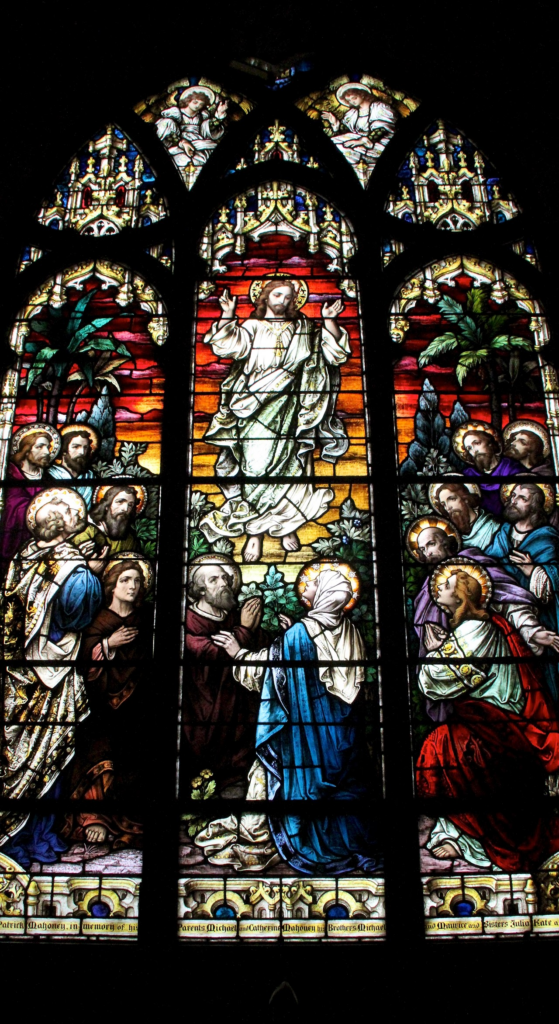
The Gothic architectural style was developed to bring sunshine into people’s lives, and especially into their churches. Gothic stained glass windows bring light and color into the church. Historically the windows convey bible stories in a colorful visual form at a time when not everyone in a population could read. They were an important means of teaching the faith to members of the church.
St. Malachy’s was designed in the Gothic style when rebuilt after a fire in 1925 .
Parishioners contracted with the most renowned firm of the time – the Franz Mayer and Company of Munich, Germany, stained glass artists to the Vatican and Catholic churches worldwide. In 1892, Pope Leo XIII had designated the company a “Pontifical Institute of Christian Art.”
In “The History of St. Malachy’s Church, Sherburne, NY,” published in 1958, author Alice Dinneen states: “Both the Stations of the Cross and the lovely stained glass windows depicting scenes in the life of Our Lord, were imported from Mayer and Co. of Munich, Bavaria, at a cost of $4,500. The windows, flooded with sunlight, are inspiring and beautiful to behold.”
The largest and most awe-inspiring of the windows is the eight feet wide by 13-feet tall Ascension window which dominates the south-facing choir gallery which overlooks the interior of the church.
The main section of the church is resplendent, decorated by eight, three-light windows – 5’x9′ each – depicting significant events in Christ’s life. The four windows on the gospel side of the church feature events in the early life of the Savior. According to Mayer and Company’s order books, these are titled: the Nativity and Adoration of the Kings, the Presentation in the Temple, the Finding in the Temple, and Home at Nazareth.


the Temple

the Temple

The windows on the epistle side of the aisle focus on Christ’s public ministry, and are listed in the company’s books as Handing over the Charge to St. Peter, Mary Magdalene anointing Christ’s feet, Christ stilling the Tempest, and the Marriage Feast at Cana. Angels adorn the trefoil and qua trefoil sections of each window. Tenney remembers looking up at the angels during services when she was a child and marveling that they were not identical. The celestial beings are depicted with many different facial expressions with their arms in a variety of positions.

first public miracle



Feed my sheep


These are ensconced in adjoining walls and are just above eye level, making it easier for the viewer to admire the still vibrant colors of the glass and the intricate, artistic details. The small baptistery to the left of the altar is radiant with light streaming through the stunning, two-light windows — Christ blessing the Children and Christ with Nicodemus.
Mayer and Company’s archives also document that the church ordered two iconographic windows for the sanctuary — The Pascal Lamb and Pelican, with emblems of the four Evangelists. The Pascal Lamb and Pelican are particularly appropriate for the sanctuary. The lamb signifies Christ’s willingness to be crucified for the redemption of mankind. According to legend, the pelican plucks her own breast to feed her chicks with her blood during a period of drought. The bird therefore symbolizes the church which sustains and cares for the faithful.
In “A Handbook of Christian Symbols and Stories of the Saints”, author Clara Erskine Clement explains the significance of each evangelist’s icons. St. Matthew, whose writing focuses on Christ’s humanity, is symbolized by a cherub which closely resembles the human form; the regal lion represents St. Mark whose writings draw attention to Christ’s royalty; St. Luke’s emblem is the ox, a symbol of sacrifice and aptly represents Christ’s priesthood; St. John is represented by an eagle, “as an emblem of the lofty flights of his inspiration.”
Stations of the Cross
The Stations of the Cross positioned around the church are original works created by the Franz Mayer and Company in Munich, Germany.
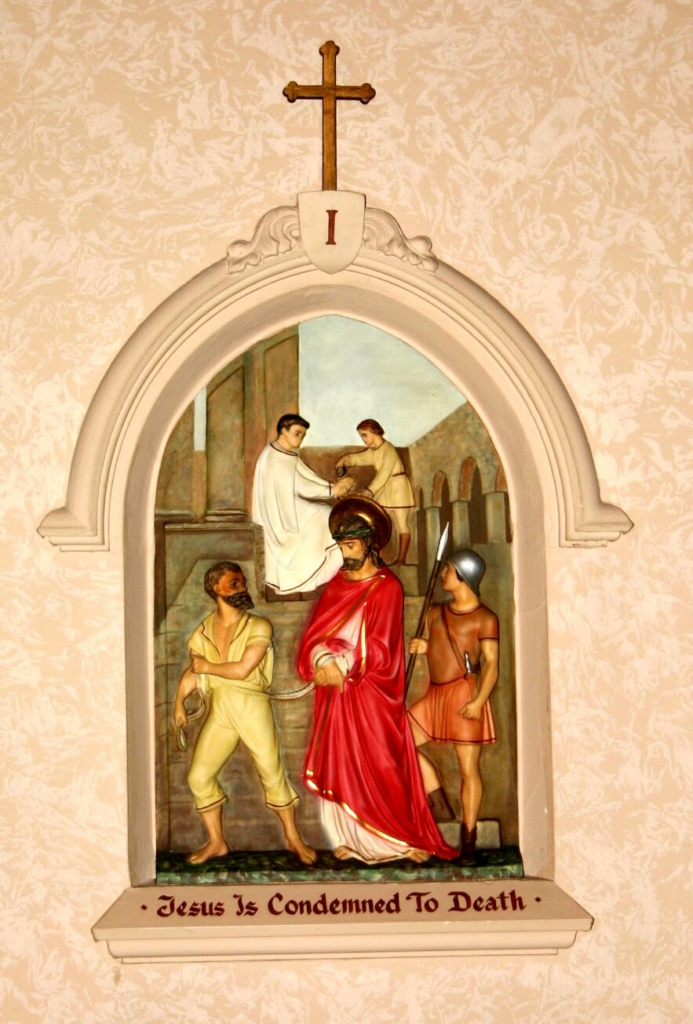
to death
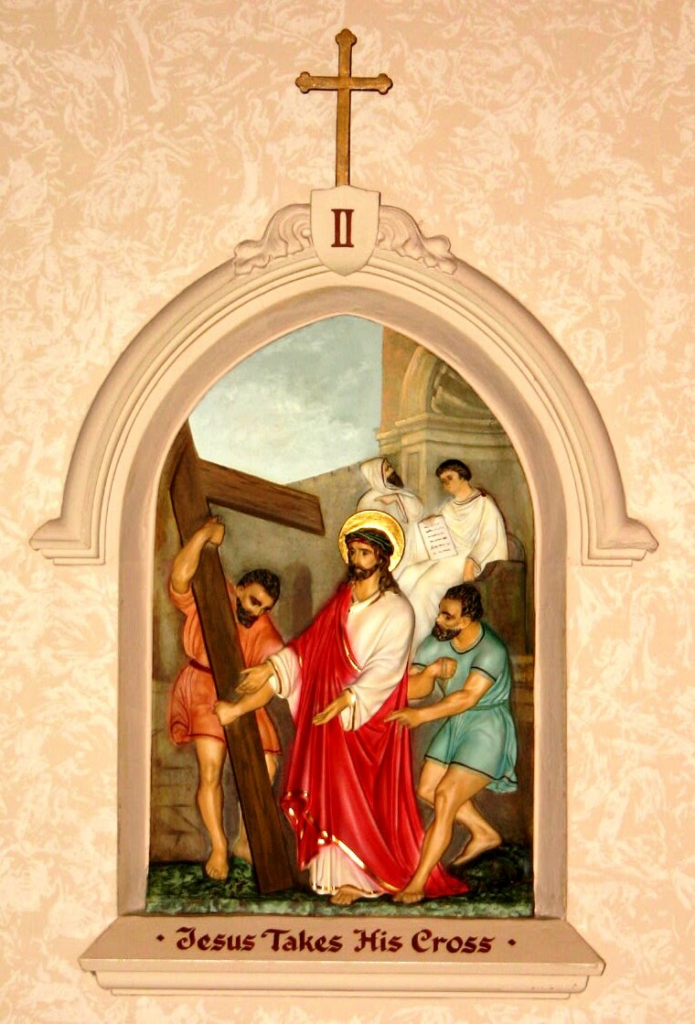
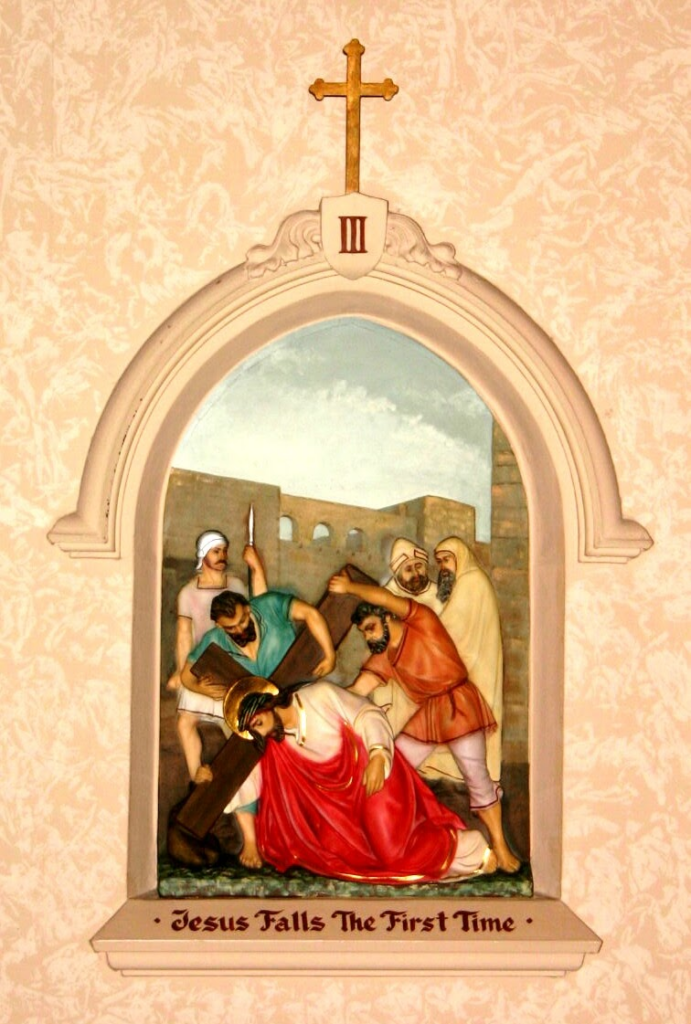
the first time
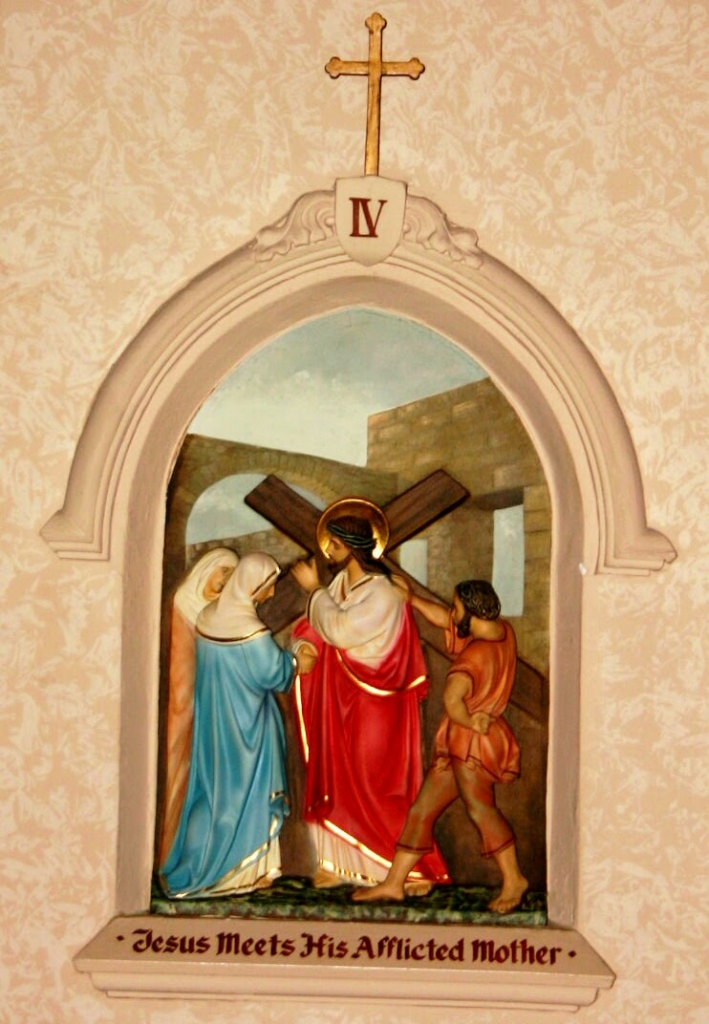
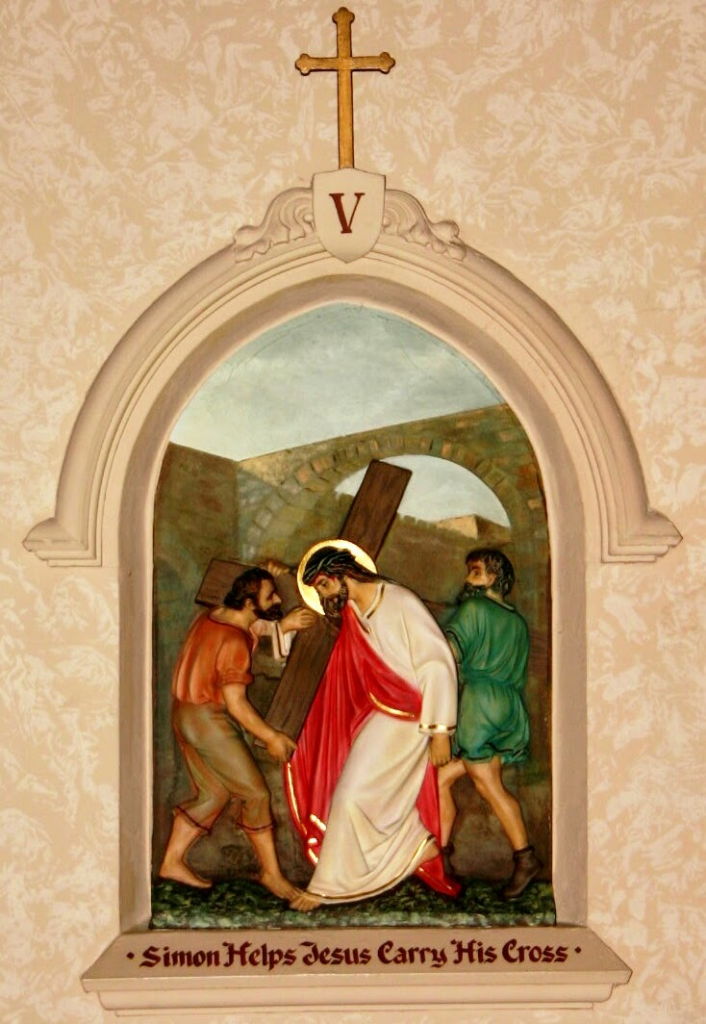
carry his cross
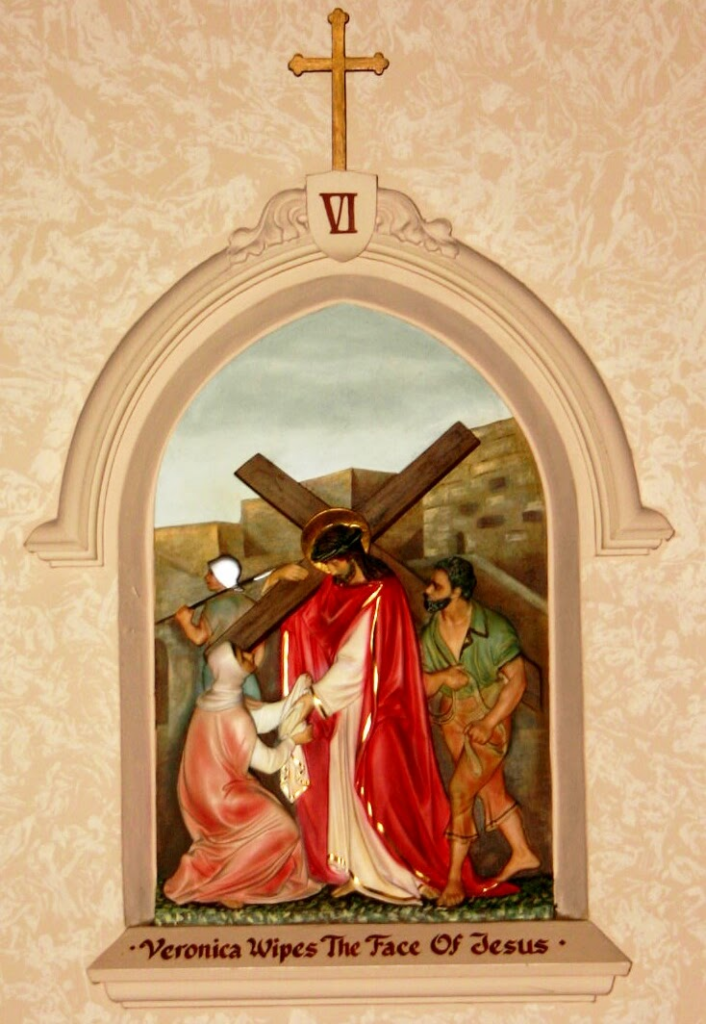
the face of Jesus
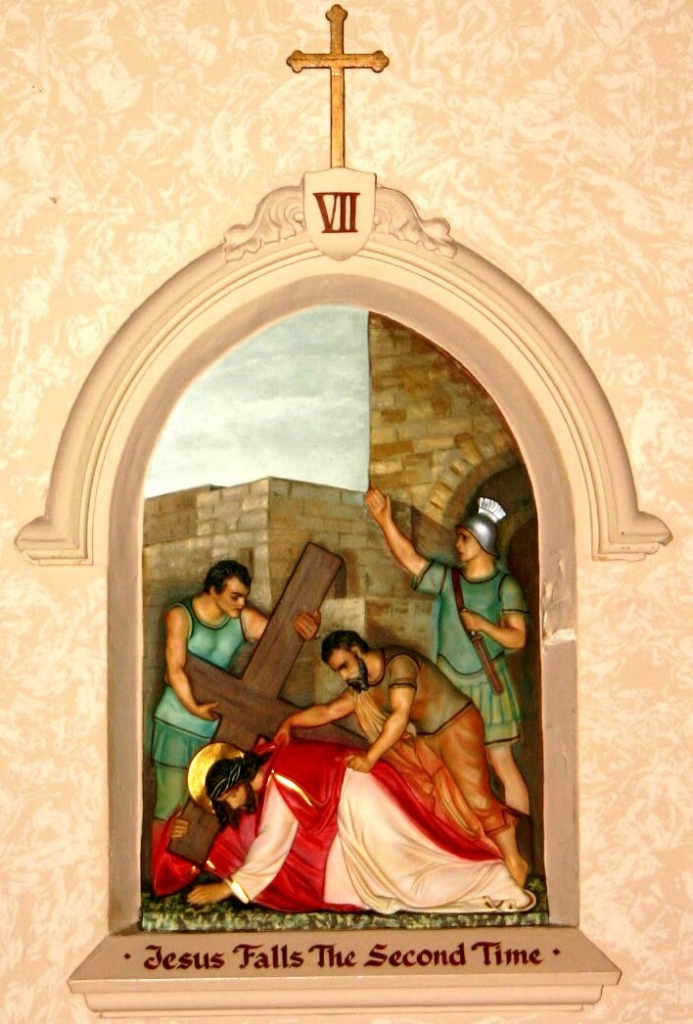
second time
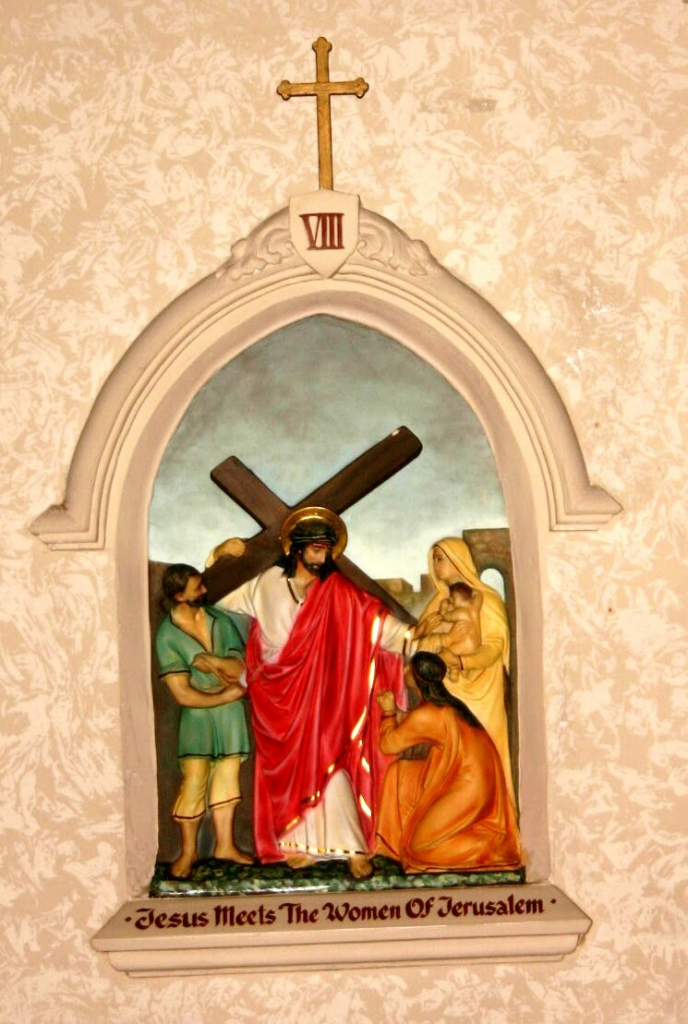
women of Jerusalem
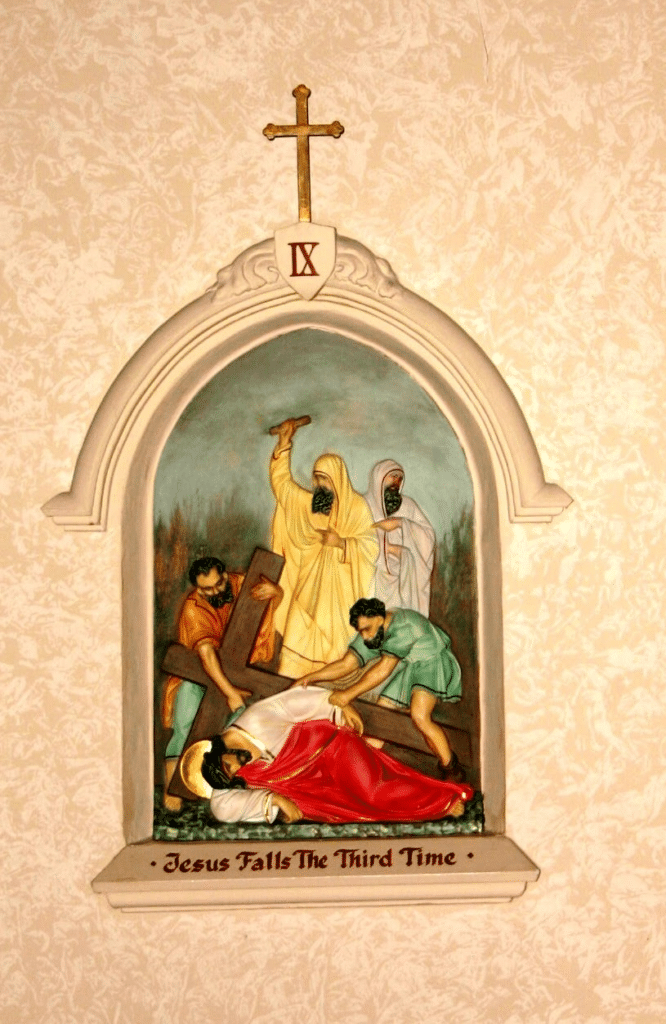
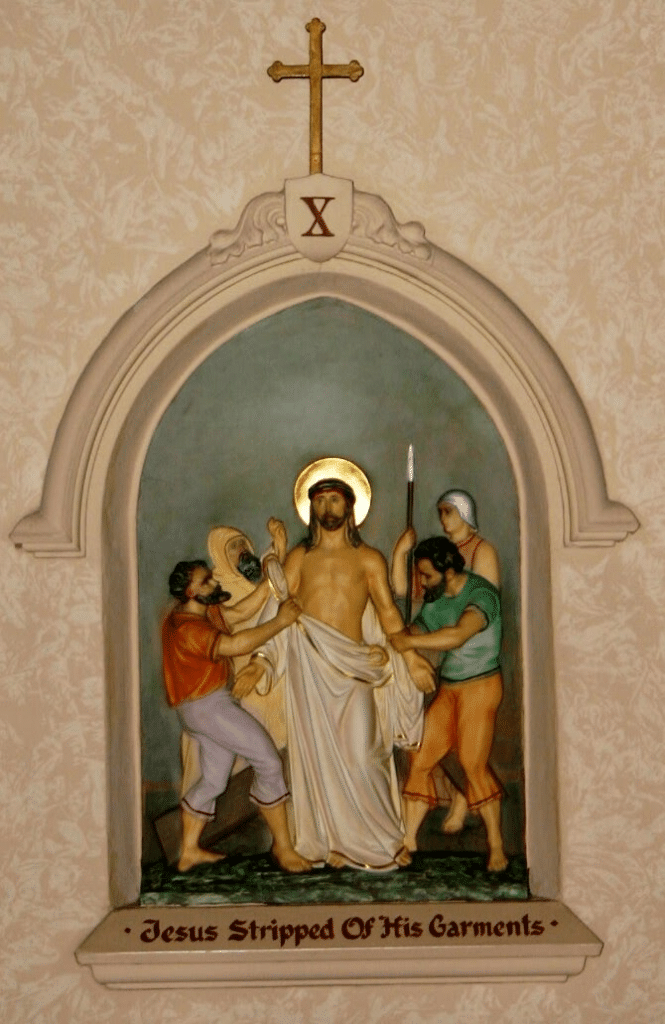
of his garments
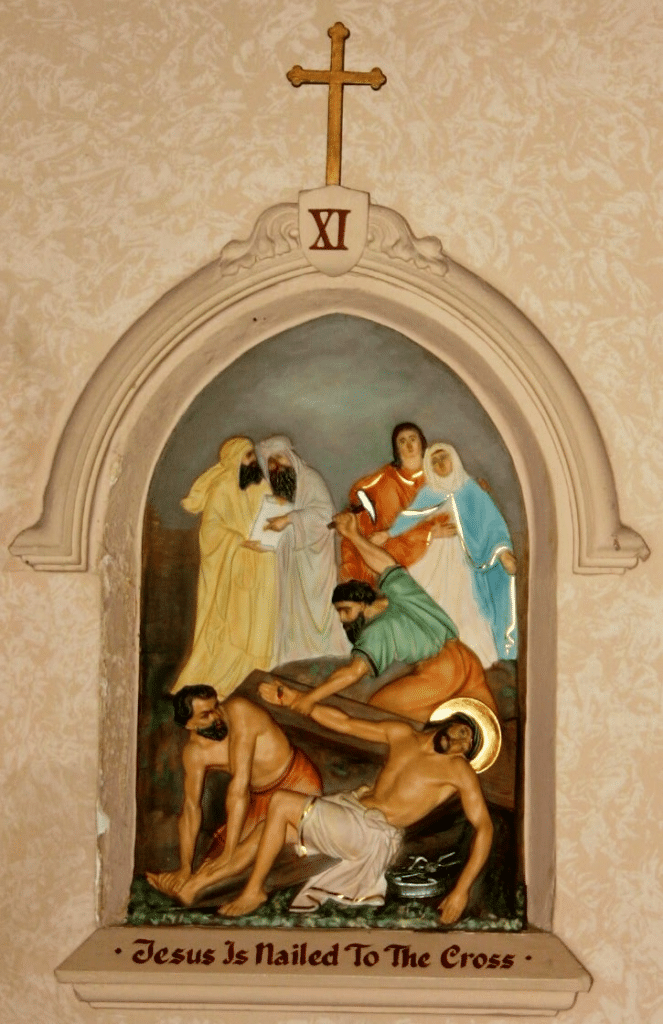
to the cross
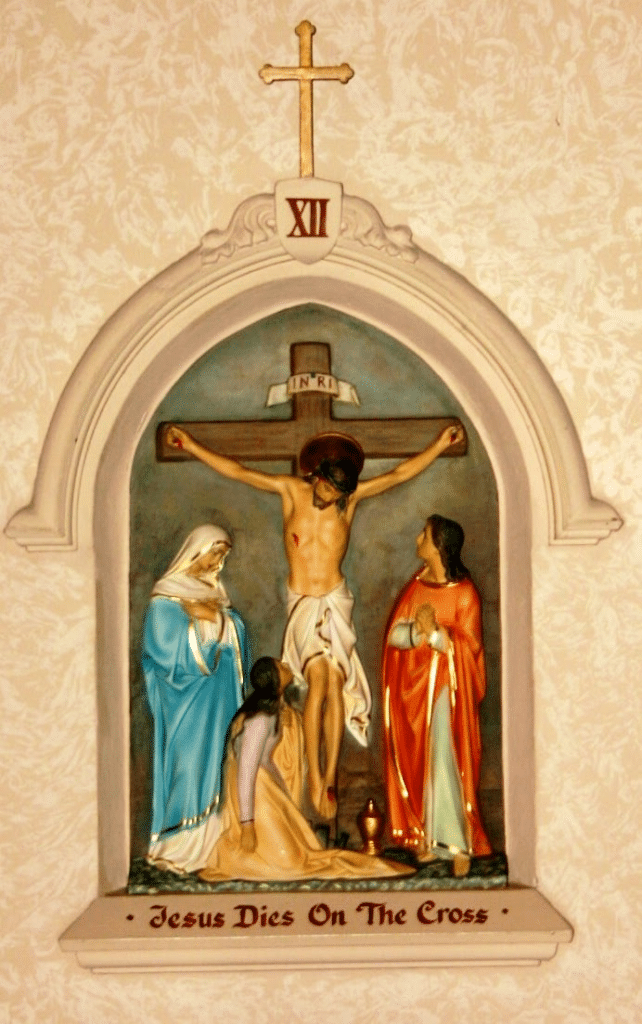
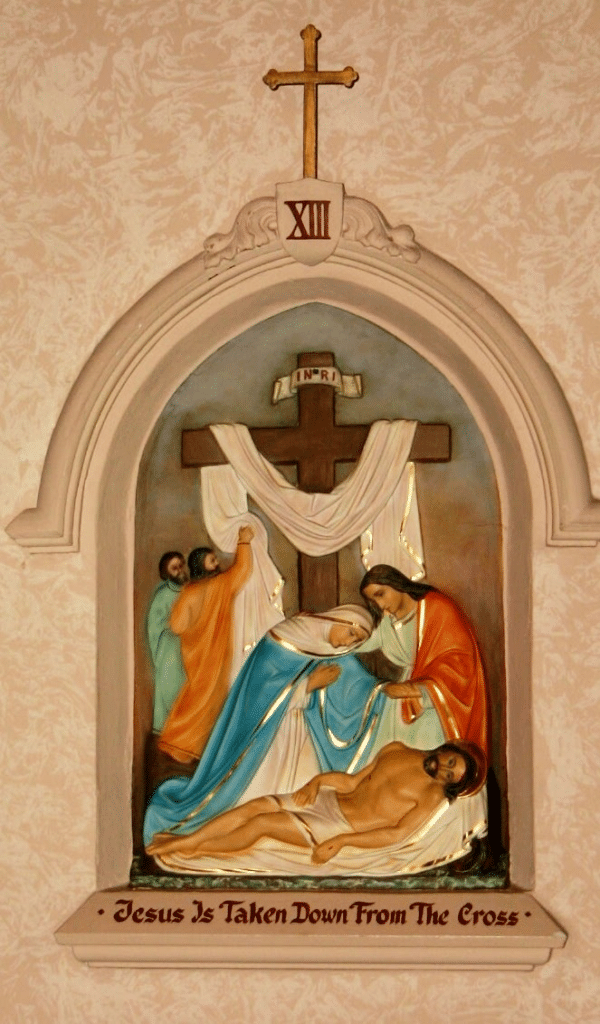
from the cross
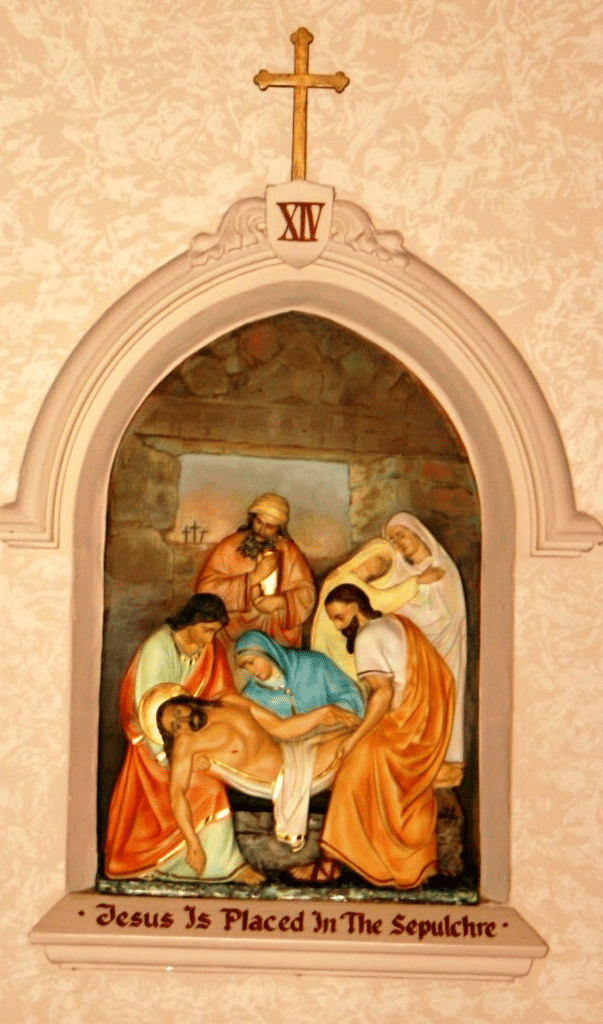
in the sepulcher
